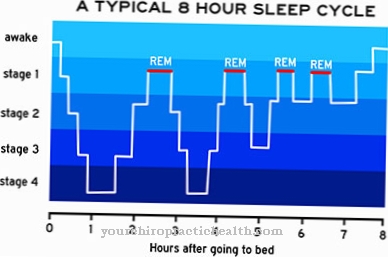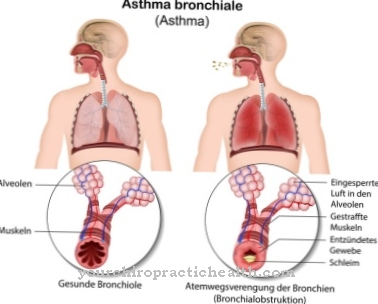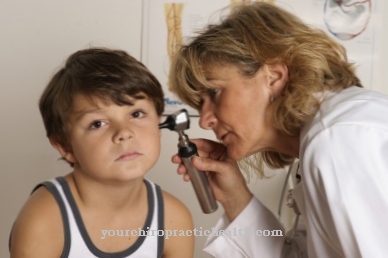Vesicles are possible symptoms of various skin diseases. In order to be able to counteract vesicles in the long term, it is therefore usually first necessary to determine the corresponding causes of vesicle.
What are vesicles?
.jpg)
© MicroOne - stock.adobe.com
Blisters (also known as vesicles in medicine) are collections of fluid that can arise, for example, under the so-called dermis or under the cornea.
These accumulations of fluid are called vesicles when individual vesicles have a diameter no larger than 5 millimeters. The fluid contained in the vesicles can be bloody-watery or clear. There are generally no collections of pus in the vesicle; if this is the case, corresponding accumulations of fluid are referred to, for example, as pustules. Because of their relatively thin vesicle cover, vesicles are usually easy to injure.
Depending on the cause (s) of the formation of vesicles, vesicles can take on different forms; for example, vesicles can appear individually or in groups. In addition, depending on the cause of their formation, blisters can be associated with pain to touch or itching, among other things.
causes
There are many possible causes of the formation of vesicles; As a rule, the vesicles are based on various skin disorders. For example, vesicles can show up as allergic reactions. For example, various contact allergies can lead to the formation of blisters.
Infectious diseases can also cause blisters to appear; here, for example, blisters develop in the case of herpes simplex (such as cold sores) or smallpox. The disease herpes zoster, known colloquially as shingles, can lead to the formation of grouped blisters.
Various autoimmune diseases (the immune system reacts excessively to the body's own tissue) that affect the skin can also cause vesicles. If vesicles are ultimately caused by blood clotting disorders or vascular inflammation, these vesicles are often enriched with blood.
Symptoms, ailments & signs
The signs of vesicles are obvious: the surface of the skin begins to redden and itchy, and at the same time tiny bumps are formed that gradually fill with fluid. This liquid mainly consists of water, but mixtures of blood and water also occur in some species. By definition, the vesicles are up to five millimeters in size, anything above that counts as a vesicle. The vesicles usually appear in clusters and in bundles.
Most types of blisters, especially those from the very common herpes virus, are very itchy. However, scratching or rubbing increases the itchiness and should be avoided. Since the vesicles stretch and stretch healthy skin very strongly, there is also direct skin pain. The pain in sensitive areas of the body, for example the face, lips or hands, is particularly unpleasant.
Many types of vesicles also begin to ooze as they develop. A hard scab then forms, but it only sits loosely on the injured skin underneath. If the scab is removed, it leads to minor bleeding and increased wound pain. Healing blisters usually leave an open skin wound, in the place of which a small scar will later form. The affected area is particularly susceptible to the same type of vesicle in the future.
Diagnosis & course
The presence of vesicles can be diagnosed based on their appearance; Information about a possible cause behind the vesicles is usually provided by patient information about the history of vesicles that have occurred. Based on the formation of vesicles and the nature of the fluid that has collected in the vesicles, a suspected diagnosis is often possible.
If the vesicles alone do not allow a conclusive diagnosis of the cause, blood or allergy tests, for example, can confirm a suspected diagnosis of vesicles.
The course of the vesicles that appear is primarily dependent on the course of the disease on which the vesicles are based. If a corresponding disease can be successfully treated or cured, the severity of the blisters that have appeared usually also improve or disappear completely.
Complications
The complications with vesicles depend on their causes. In most cases, it is about infections and inflammations, which can be limited relatively well with the help of good hygiene and with the help of medication. The vesicles can develop in different parts of the body and thus contribute to reduced aesthetics.
In many cases, patients do not feel beautiful and suffer from reduced self-esteem or from inferiority complexes. It is not uncommon for the blisters to be painful and thus limit the patient's everyday life and reduce the quality of life. Often the affected areas of the skin itch, although the patient should never scratch the skin. In the case of allergies, there is usually no causal treatment; only the symptoms can be alleviated.
Often the patient then has to do without a certain ingredient. Furthermore, inflammations and infections can be fought with the help of medication. With early treatment, there are usually no complications. Treatment by a doctor is always recommended to prevent scarring. If the pain is severe, the patient can also take pain relievers.
When should you go to the doctor?
It is generally advisable to consult a doctor at an early stage if blisters appear. A rapid start to treatment can reliably prevent the symptoms from worsening and contribute to recovery. A doctor should be consulted as soon as unusual skin changes and cavities that may be filled with fluid are noticed. This is especially true when home remedies and self-measures such as changing your diet or avoiding stress do not have the desired effect.
Medical clarification is particularly urgent if the vesicles become inflamed or rapidly increase in size and number. If you have painful or itchy vesicles, you should go to the doctor's office immediately. Most of the time, the vesicles are due to a harmless cause that can be determined by taking a medical history. Then the trigger (e.g. a certain medication or a lack of personal hygiene) can be treated in a targeted manner.
If this does not reduce the vesicles, the doctor will refer the patient to an appropriate specialist. Patients with infectious diseases such as herpes and smallpox or autoimmune diseases should speak to their specialist in the event of sudden skin changes.
Doctors & therapists in your area
Treatment & Therapy
In order to treat vesicles successfully in the long term, a detailed diagnosis of the cause is usually required first; If the cause behind the formation of vesicles can be discovered, the vesicles can usually also be treated by combating the causes.
Basically, experts advise to consult a doctor at an early stage if vesicles occur; because an early start of treatment usually contributes to the fact that symptoms such as vesicula do not worsen and that an improvement can occur more quickly.
Once the cause has been diagnosed, a distinction must then be made between the causal and the symptomatic treatment of vesicles: Symptomatic treatment of vesicles can consist in relieving pain or itching on the areas of skin affected by the vesicles. This can be done, for example, by applying individually suitable lotions or tinctures. If the pain is very severe, painkillers can also be used for blisters.
A causal treatment of vesicles then takes place through the therapy of the underlying disease: For example, if viruses are the cause of vesicles (as in shingles), so-called antivirals (drugs that fight viruses) can be used. In the case of a contact allergy that leads to vesicles, avoiding allergy-triggering stimuli can heal vesicles that have appeared.
Outlook & forecast
Patients with blistering usually have a very good prognosis. The vesicles recede completely within a few days and the patient is symptom-free and healed. The use of medical treatment must be decided on an individual basis. Small vesicles do not always require medical attention because they heal on their own within a short time. Many sufferers therefore forego treatment and rely on the body's self-healing powers or the use of home and natural remedies.
As long as there are no complications, these methods have proven their worth. With medical care, however, the patient can be helped more extensively. Research into the causes provides information about the reasons for the occurrence and can therefore be used to prevent the formation of new vesicles. In addition, the blisters heal faster with the support of drug treatment. The risk of infection is also reduced as there are fewer open wounds.
Despite the good prospects of healing, the blistering can return at any time. The prognosis in these cases is also very optimistic and will not change. Delays can occur if the patient has a drug intolerance or opens the vesicles on his own initiative. The escaping fluid can contribute to an increase in the number of blisters and the symptoms increase.
prevention
To prevent blisters, for example, regular visits to the doctor can be useful; Diseases that can cause vesicles can thus be diagnosed earlier and treated accordingly. If vesicles have already appeared, a quick visit to the doctor can help prevent the vesicles from worsening.
Aftercare
Statements on medical aftercare cannot be made in the case of blisters. After all, the vesicles have very different causes. Accordingly, follow-up care is usually based on the underlying disease and never just on the vesicles themselves. In addition, most vesicles heal without complications and without consequences, which also makes follow-up care unnecessary.
However, if the skin is badly damaged, it can be useful to take precautionary measures in the weeks after the blisters have healed. This includes, above all, careful handling of the skin: scratching, too hot showers, excessive use of soaps and tight, abrasive clothing disrupt the healing process and can cause infections to flare up again.
Excessive heat, exertion, and stress should be avoided as sweat is also bad for skin healing. In addition, in the event that the vesicles have led to open wounds, it can be useful to use ointments and the like. Good hygiene is advisable for very severely affected areas, the upper layers of which have been destroyed.
Otherwise follow-up infections can occur. Regular hand washing is particularly relevant during and after the appearance of vesicles, as unconscious scratching poses a certain risk of infection and injury.
You can do that yourself
A doctor's diagnosis is usually required for the successful treatment of vesicles. Depending on the cause, the medical treatment can then be supported by various self-measures and some resources from the budget and nature.
First of all, the hygiene measures should be adapted to the skin disease. Correct shower behavior (water temperature 32 to 38 degrees, showering no longer than five to ten minutes) can reduce further skin irritation.The use of gentle care products also contributes to healthy skin and the rapid healing of blisters. In addition, those affected should pay attention to a balanced diet, regular exercise and avoidance of stress. All of these factors ensure a better complexion and are best seen as a supplement to medical treatment.
Pain or itching can be treated symptomatically by applying soothing ointments from the drugstore, as well as aloe vera, compresses with apple cider vinegar or lemon juice. Teas made from mint oil, butterbur, devil's claw or willow bark relieve pain and inflammation. If, despite all the measures, further blisters develop, the following applies: do not scratch or prick. It makes more sense to visit the doctor again or to see a dermatologist.








.jpg)



















